For decades, it was a truth universally acknowledged that any action blockbuster must be in need of a massive, building-leveling explosion. But in recent years, as filmmakers have become untethered from practical effects and freed to think in pixels, we’ve seen a succession of new clichés arise.
First, Hollywood’s explosions began to collapse in on themselves, and—as I wrote in 2012—we saw a boom in implosions. Instead of going out with a bang, buildings and planets began to crumple inward. This began in 2009’s Star Trek, continued with 2012’s The Avengers and The Dark Knight Rises, and finally achieved its gravitational singularity with the black-hole–like implosion grenades of 2013’s Thor: The Dark World.
Next, in another twist that seemed designed to crudely tap into the trauma of Sept. 11, Hollywood began to send massive spaceships crashing into our skylines. Once again, J.J. Abrams’ Star Trek movies led the way, with 2013’s Star Trek Into Darkness flinging down the oversized USS Vengeance to level Starfleet Headquarters (along with much of the Bay Area). Marvel soon followed Abrams’ lead, reproducing this climax with skyscraper-sized spaceships plowing into the good guys’ home base in both Guardians of the Galaxy and Captain America: Winter Soldier (both 2014).
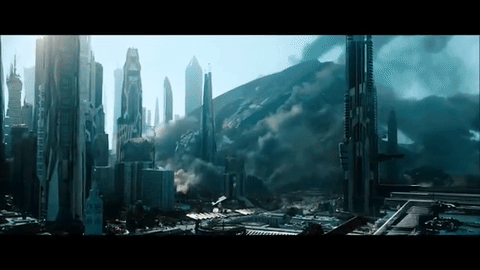
GIF by the author
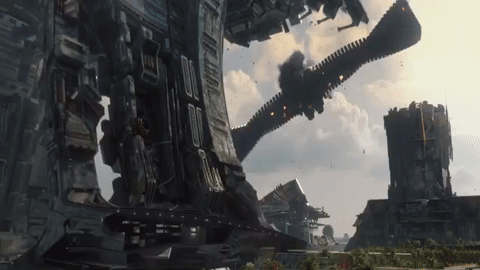
GIF by the author
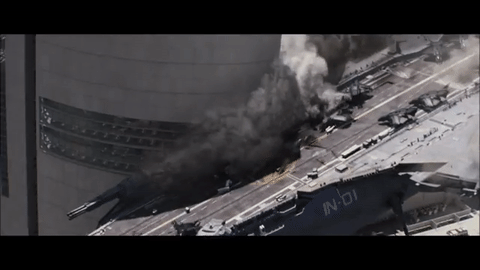
GIF by the author
But now, Hollywood has a new rule: What used to go down now must come up. This new pet method for mass urban destruction arose around the same time the previous trends reached their own apex. The first major example (as far as I or anyone at Slate can recall) came in 2013’s Man of Steel, in which Michael Shannon’s General Zod fires up his “Phantom Drive,” which distorts Earth’s gravity in such a way that all nearby objects are lifted into the air before it flings them back downward.
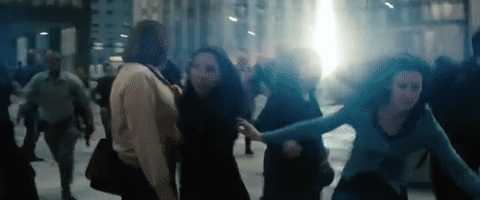
GIF by the author
The following year, Michael Bay introduced a more crude weapon of mass destruction. “That’s a big magnet!” Mark Wahlberg’s Cade Yeager helpfully observes in Transformers: Age of Extinction. “It’s sucking up metal then dropping it.” Because it’s a Michael Bay movie, this goes on for a solid five minutes.
The pop culture–savvy Ultron must have seen one of these movies, because in the following summer’s Avengers sequel, he hatched more or less the same plan as Zod and Transformers’ Lockdown, airlifting the entire capital city of the fictional country of Sokovia into the sky before threatening to smash it back down like an asteroid.

GIF by the author
Though that’s three cities sucked into the sky in the last three summers, the summer of 2016 has seen this trend reach a new height in popularity. In X-Men: Apocalypse, which was released on Memorial Day weekend, Oscar Isaac’s Apocalypse and Michael Fassbender’s Magneto combine their powers to lift the entire planet’s metal into the sky.
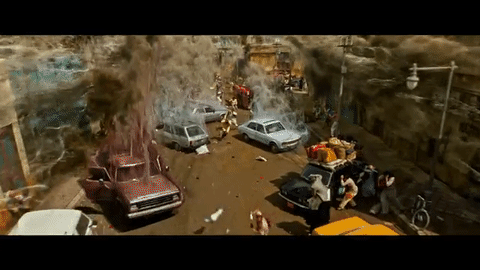
GIF by the author
And while the aliens of the original Independence Day methodically destroyed each of the world’s landmarks from the top down, the new sequel rips them from the ground up. As Jeff Goldblum’s David Levinson explains, the new mothership is so big that “it has its own gravity.”
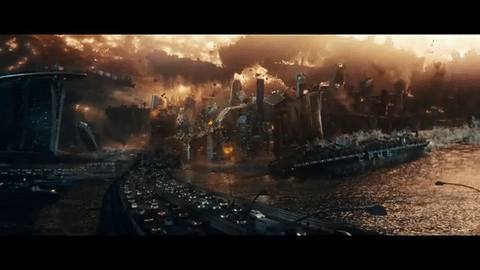
GIF by the author
How did this become the hottest new trend in urban destruction? One reason is that it allows filmmakers who are squeamish about making entertainment out of catastrophe to convince themselves that they’re creating a spectacle without as high a body count. As Apocalypse writer-producer Simon Kinberg told the Empire Film Podcast, “We tried to keep it so that the things that he was destroying felt almost more like monuments or the rooftops of buildings, rather than a building toppling over and people dying.” Director Bryan Singer is “very, very sensitive to collateral damage,” he explained, and he was aware that casually inflicting mass casualties is “something that people are very critical of in a lot of different movies.” Similarly, the climax of Ultron finds the Avengers explicitly focused on avoiding the amount of civilian casualties that occurred at the end of the first film, in which their fight with the Chitauri finds them destroying large chunks of midtown Manhattan.
At a time when critics and many audiences are fed up with popcorn flicks exploiting the trauma of 9/11, these set pieces also provide a way to depict mass destruction without evoking the collapse of the Twin Towers. If anything, as Slate’s Dana Stevens notes in her review, the image of people and buildings falling up “suggests not so much the end of days as the rapture.” I’m sure this wasn’t lost on the makers of X-Men: Apocalypse, which is packed with references to the Book of Revelation, and includes the Four Horsemen of the Apocalypse (here played by mutants) as principals.
This new way of obliterating cities also turns one of CGI’s most persistent weaknesses into a strength. As Adam Sternbergh argued in the New York Times in 2012, explosions were once one of the three main components of the modern American action film, but then “computer animation gobbled up everything, chewing it all into weightless pixels.” Magnets and gravity-distorting weapons then turn that weightlessness to the movie’s advantage.
And, for a time, this was relatively novel. Whatever you think of these climactic, city-destroying set pieces, they’re at least different from the climactic, city-destroying set pieces that came before. The only major precedent I can think of is from, of all movies, 1987’s Spaceballs, which features a massive spaceship transforming into what the villains call “Mega Maid,” a Death Star–like superweapon complete with a giant vacuum cleaner to suck up all the oxygen on the heroine’s home planet. As it commences its hoovering, Dark Helmet and his team chant, “Suck! Suck! Suck!”
But what was once Hollywood’s newest, hottest method of mass destruction has now become just its latest cliché. While fresher action blockbusters like Deadpool and Captain America: Civil War are going in a bold, new direction by not destroying any world capitals at all, these movies all zagged in the same direction. And that really does suck.
